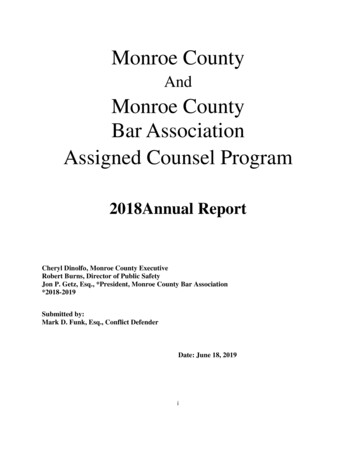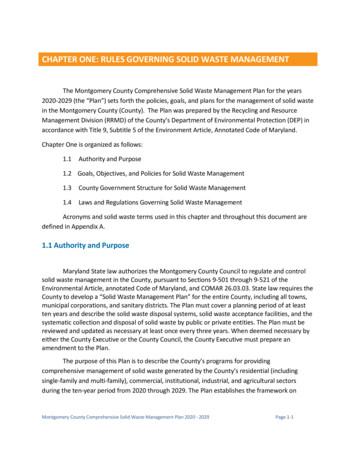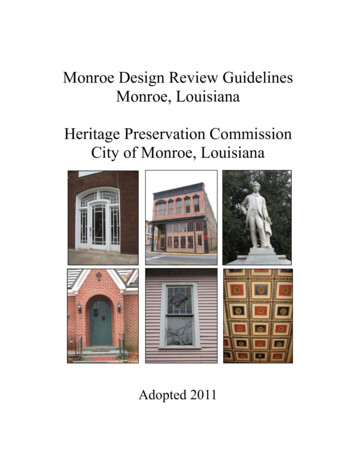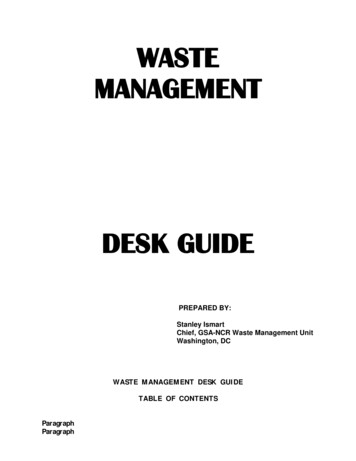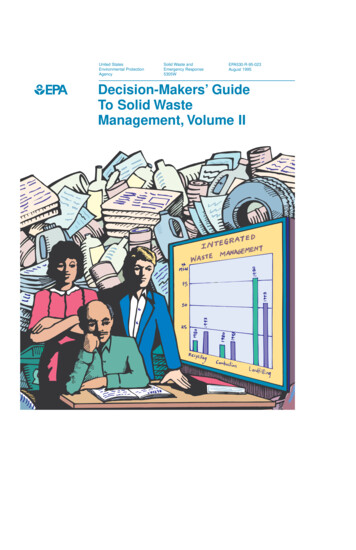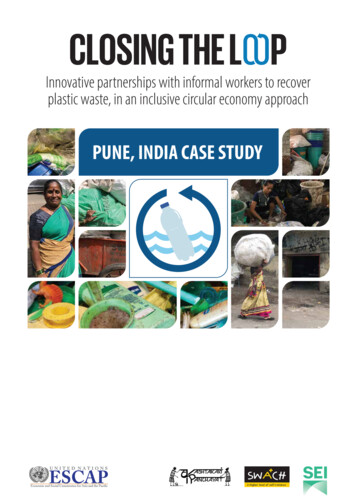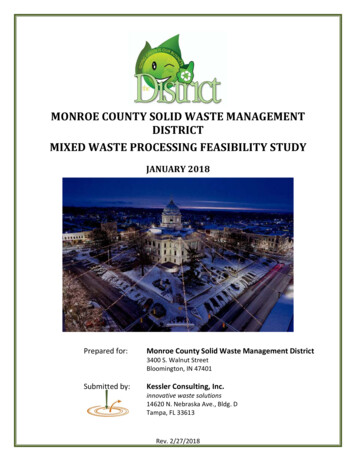
Transcription
MONROE COUNTY SOLID WASTE MANAGEMENTDISTRICTMIXED WASTE PROCESSING FEASIBILITY STUDYJANUARY 2018Prepared for:Monroe County Solid Waste Management District3400 S. Walnut StreetBloomington, IN 47401Submitted by:Kessler Consulting, Inc.innovative waste solutions14620 N. Nebraska Ave., Bldg. DTampa, FL 33613Rev. 2/27/2018
This report has been prepared for the use and benefit of the client for the specific purposesidentified in the report. The conclusions, observations, and recommendations contained hereinattributed to Kessler Consulting, Inc. constitute the opinions of Kessler Consulting. The servicesprovided by Kessler Consulting and this report are not intended for the benefit of any thirdparty and shall not be relied upon by any third party. To the extent that statements,information, and opinions provided by other third parties have been used in the preparation ofthis report, Kessler Consulting has relied upon the same to be accurate, and for which noassurances are intended and no representations or warranties are made. Kessler Consultingmakes no certification and gives no assurances except as explicitly set forth in this report.Copyright 2016, Kessler Consulting, Inc.All rights reserved.Kessler Consulting, Inc. is a member of, or was awarded, the following:
Table of ContentsList of Acronyms . viExecutive Summary.viiSection 1Introduction . 1Overview. 1Background . 1Acknowledgments . 2Section 2Regional Waste Management System . 3Introduction . 3Summary of District Solid Waste Management System . 3Regional Solid Waste Management System. 4Monroe County . 4Morgan County . 5Lawrence County . 6Jackson County . 7Greene County. 7Owen County . 8Brown County . 8Out‐of‐Region . 8Regional Mixed Waste Flow . 9Mixed Waste Projections . 12Section 3Waste Processing Technology Assessment . 13Introduction . 13Intermediate Processing Facility . 14Overview. 14Materials Handled . 15Major Facility Components . 15Products & Byproducts . 15Performance . 16Scalability & Economics . 16Materials Recovery Facility. 16iMonroe County SWMD/Deliverables/Final Report ‐ rev022718
Monroe County SWMDMixed Waste Processing Feasibility Study Final ReportTable of ContentsOverview . 16Materials Handled . 17Major Facility Components . 17Products & Byproducts. 18Performance . 19Scalability & Economics:. 19Mixed Waste Processing Facility . 20Overview . 20Materials Handled . 21Major Facility Components . 21Products & Byproducts. 22Performance . 22Scalability and Economics . 23Potential Applicability to the District and Region . 23Capacity . 24Compatibility . 25Availability . 25Section 4Waste Composition Study . 27Introduction . 27Methodology . 27WCS Results . 29Introduction to Results. 29District Mixed Waste . 31City Mixed Waste . 34IU Mixed Waste . 37Private Hauler Mixed Waste . 40Out‐of‐County Mixed Waste . 43Comparability of WCS Results . 46Section 5Materials Processing Scenarios: Assumptions and Projections . 47Introduction . 47Scenario 1: IPF with Additional District Collection Services. 48Scenario 2: MRF with Additional District Collection Services . 51Scenario 3: MWF with Additional District Collection Services. 54Scenario 4: Organics Composting Facility . 58Summary . 61Section 6Feasibility Assessment . 63iiMonroe County SWMD/Deliverables/Final Report ‐ rev022718
Monroe County SWMDMixed Waste Processing Feasibility Study Final ReportTable of ContentsScenario 1: IPF . 63Cost Estimates for Potential New District Collection . 63IPF Design Capacity. 64IPF Design and Operating Features . 64IPF Cost Estimate and Financial Projection . 65Scenario 2: MRF . 67Cost Estimates for Potential New District Collection . 67MRF Design Capacity . 68MRF Design and Operating Features . 68MRF Cost Estimate . 69Scenario 2 Hybrid . 71Scenario 3: MWF . 71Cost Estimates for Potential New District Collection . 71MWF Design Capacity. 72MWF Design and Operating Features . 72MWF Cost Estimate . 73Scenario 4: OCF. 75Cost Estimates for Potential New District Collection . 75OCF Design Capacity . 75OCF Design and Operating Features . 76OCF Cost Estimate . 76Assessment of Strategic Factors. 78Design Capacity, Available Tonnage and Financial Viability . 78Legal and Contractual Matters . 79Financing Facility Development . 80Public‐Private Partnerships . 81Stakeholder Impacts . 82Section 7Summary and Conclusions . 84iiiMonroe County SWMD/Deliverables/Final Report ‐ rev022718
Monroe County SWMDMixed Waste Processing Feasibility Study Final ReportTable of ContentsTablesTable E‐1: Tons of Mixed Waste Generated Within Monroe County by Hauler . viiTable E‐2: Tons of Mixed Waste and Recyclables Generated in the Region . viiiTable E‐3: Facility Tonnage and Impact on County Recovery Rate . xiTable E‐4: Summary of Financial Assessment . xiiiTable 2‐1: Tons of Mixed Waste and Recyclables Collected at District Recycling Centers . 3Table 2‐2: Tons of Mixed Waste Generated Within Monroe County . 5Table 2‐3: Tons of Mixed Waste Generated Within Morgan County . 6Table 2‐4: Tons of Mixed Waste Generated Within Lawrence County . 6Table 2‐5: Tons of Mixed Waste Generated Within Jackson County . 7Table 2‐6: Tons of Mixed Waste Generated Within Greene County . 7Table 2‐7: Tons of Mixed Waste Generated Within Owen County . 8Table 2‐8: Tons of Mixed Waste Generated Within Brown County . 8Table 2‐9: Tons of Mixed Waste Generated Out of Region and Disposed within Region . 9Table 2‐10: Tons of Mixed Waste and Recyclables Generated in the Region . 9Table 2‐11: Tons of Mixed Waste Received at Regional Transfer Stations & Landfills . 10Table 2‐12: Mixed Waste Generation and MSW Projections ‐ 2020 through 2035. 12Table 3‐1: IPF Capital and Operating Cost Factors . 16Table 3‐2: Common Types of MRF Sorting and Processing Equipment . 18Table 3‐3: MRF Material Recovery Rates . 19Table 3‐4: MRF Capital and Operating Cost Factors . 20Table 3‐5: Additional Types of Equipment Used in MWF. 22Table 3‐6: MWF Material Recovery Rates . 23Table 3‐7: MWF Capital and Operating Cost Factors . 23Table 3‐8: Sources and Quantities of Materials Versus Processing Technology Options . 24Table 4‐1: Sampling Schedule . 28Table 4‐2: Composition of District Mixed Waste (% by weight). 33Table 4‐3: Composition of City Mixed Waste (% by weight) . 36Table 4‐4: Composition of IU Mixed Waste (% by weight). 39Table 4‐5: Composition of Private Mixed Waste (% by weight) . 42Table 4‐6: Composition of Out‐of‐County Mixed Waste (% by weight) . 45Table 4‐7: District and City Results Compared to Other WCSs . 46Table 5‐1: Summary of 2016 Material Generation. 48Table 5‐2: Summary of Material Flow Assumptions – Scenario 1 IPF . 49Table 5‐3: Monroe County Tonnage & Recovery Projections – Scenario 1 IPF. 50Table 5‐4: Facility Tonnage Projections – Scenario 1 IPF . 51Table 5‐5: Summary of Material Flow Assumptions – Scenario 2 MRF . 53Table 5‐6: Monroe County Tonnage & Recovery Projections – Scenario 2 MRF . 53Table 5‐7: Facility Tonnage Projections – Scenario 2 MRF . 54Table 5‐8: Summary of Material Flow Assumptions – Scenario 3 MWF . 56Table 5‐9: Monroe County Tonnage & Recovery Projections – Scenario 3 MWF. 57Table 5‐10: Facility Tonnage Projections – Scenario 3 MWF . 58ivMonroe County SWMD/Deliverables/Final Report ‐ rev022718
Monroe County SWMDMixed Waste Processing Feasibility Study Final ReportTable of ContentsTable 5‐11: Summary of Material Flow Assumptions – Scenario 4 OCF . 59Table 5‐12: Monroe County Tonnage & Recovery Projections – Scenario 4 OCF . 60Table 5‐13: Facility Tonnage Projections – Scenario 4 OCF . 61Table 5‐14: Facility Input (Design Capacity) and Impact on County Recovery Rate. 62Table 6‐1: Cost Estimate for IPF . 66Table 6‐2: 15‐Year Financial Projection for IPF . 67Table 6‐3: Cost Estimate for MRF . 70Table 6‐4: 15‐Year Financial Projection for MRF . 71Table 6‐5: Cost Estimate for MWF . 74Table 6‐6: 15‐Year Financial Projection for MWF . 75Table 6‐7: Cost Estimate for OCF . 77Table 6‐8: 15‐Year Financial Projection for OCF . 78Table 6‐9: Advantages and Disadvantages of PPP Options . 82Table 7‐1: Facility Tonnage and Impact on County Recovery Rate . 86Table 7‐2: Summary of Financial Assessment . 88FiguresFigure E‐1: Composition of District Mixed Waste . ixFigure E‐2: Composition of City Mixed Waste . ixFigure E‐3: Composition of IU Mixed Waste . xFigure E‐3: Composition of IU Mixed Waste . xFigure E‐5: Composition of Out‐of‐County Mixed Waste . xFigure 2‐1: Process Flow Diagram for Mixed Waste in the Region . 11Figure 3‐1: Waste Management Hierarchy . 14Figure 3‐2: General Flow Diagram of IPF‐based Recovery Systems . 15Figure 3‐3: General Flow Diagram of MRF‐based Recovery Systems. 17Figure 3‐4: General Flow Diagram of MWF‐based Recovery Systems . 21Figure 4‐1: Example of Mixed Waste Sampled During the WCS . 28Figure 4‐2: Sorting Activities During the WCS . 28Figure 4‐3: Composition of District Mixed Waste (% by weight) . 32Figure 4‐4: Composition of City Mixed Waste (% by weight) . 35Figure 4‐5: Composition of IU Mixed Waste (% by weight). 38Figure 4‐6: Composition of Private Mixed Waste (% by weight) . 41Figure 4‐7: Composition of Out‐of‐County Mixed Waste (% by weight) . 44Figure 7‐1: Source of Regional Mixed Waste. 84Figure 7‐2: Source of Regional Recyclables . 84Figure 7‐3: Facilities Receiving Regional Mixed Waste. 85Figure 7‐4: Composition of County Mixed Waste. 86vMonroe County SWMD/Deliverables/Final Report ‐ rev022718
List of AcronymsC&DConstruction and DemolitionCountyMonroe CountyDistrictMonroe County Solid Waste Management DisctrictEPSExpanded polystyreneG&AGeneral and administrativeGBNGreen Business NetworkHDPEHigh density polyethyleneHoosierRepublic Services, dba Hoosier Disposal and RecyclingIDEMIndiana Department of Environmental ManagementIPFIntermediate processing facilityIUIndiana UniversityKCIKessler Consulting, Inc.MRFMaterials recovery facilityMSWMunicipal solid wasteMWFMixed waste processing facilityOCFOrganics composting facilityPETPolyethylene terephthalatePPPPublic‐private partnershipRegionMonroe County and adjacent countiesSWMDSolid Waste Management District, referring to districts in adjacent counties.WCSWaste composition studyviMonroe County SWMD/Deliverables/Final Report ‐ rev022718
Executive SummaryOverviewThe District contracted with KCI to conduct a materials processing feasibility study to help drivethe District’s policy, program, and infrastructure decisions. The study involved a series ofspecific tasks: Assessment of the existing waste management system, a waste compositionstudy, a technology assessment, defining material processing scenarios, and an assessment ofthose scenarios. After each task, KCI submitted a technical memorandum to the District thatserved as progress reports to facilitate ongoing input from the District and refinement of theproject. This final report is an integration and synthesis of those memoranda into aconsolidated document.Regional Waste Management SystemAs a first step in the feasibility study, KCI researched the solid waste management system inthe Region. The purpose of this research was to understand the types and quantities of MSWgenerated, how it is collected, who controls the waste, and where it is ultimately disposed.This information established a baseline understanding regarding the availability of materialsneeded for assessing the feasibility of processing options.Table E‐1 shows the tons of mixed waste collected in the County by which hauler and its finaldisposition. Most mixed waste collected in the County is collected by private haulers(approximately 88 percent), while the District, the City, and IU collected the remainder. Nearly92 percent of the mixed waste collected in the County is disposed at the Hoosier TransferStation, including all mixed waste collected by public haulers.Table E‐1: Tons of Mixed Waste Generated Within Monroe County by HaulerHaulerCityIUDistrictPrivate HaulersPrivate HaulersPrivate HaulersPrivate 89118,075Percent4%6%2%Transfer StationHoosierHoosierHoosierHoosier*Rays*88%Final DisposalSycamore RidgeSycamore RidgeSycamore RidgeSycamore RidgeMedora**Indy RRP100%*Direct hauled. **Transferred out of Region.Table E‐2 shows the tons of mixed waste and recyclables collected in the Region.Approximately 44 percent of mixed and 71 percent of recyclables are generated in the County.Private haulers collect and control most of mixed waste. Conversely most recyclables arecollected by public entities in the Region, in particular, the county solid waste managementdistricts. The City and IU also generate a significant amount of recyclables. Except for the City,most recyclables are collected as source‐separated recyclables.viiMonroe County SWMD/Deliverables/Final Report ‐ rev022718
Monroe County SWMDMixed Waste Processing Feasibility Study Final ReportExecutive SummaryTable E‐2: Tons of Mixed Waste and Recyclables Generated in the rownTotalOut‐of‐RegionMixed 956N/AWaste Processing Technology AssessmentThe three types of physical processing facilities that were assessed in this project were: IPF MRF MWFIPFs are the most basic form of materials processing. They primarily prepare materials for saleas commodities with limited sorting to segregate materials or remove contaminants. Theyreceive source‐separated materials and generate very little residue. However, due to therequirement to source separate, communities with only an IPF usually have lower diversionrates because of lower generator participation. Compared to other processing options, IPFshave a lower cost to construct, due to less equipment, and a lower net operating cost per ton.IPFs are generally associated with smaller community recycling programs and handle a fewtons per hour of materials.MRFs receive commingled recyclables, generally dual stream or single stream, that have beensource‐separated from mixed waste. They use a combination of mechanical technologies andmanual processes for sorting materials into marketable commodities. MRFs produce moreresidue than IPFs because some of the inbound recyclables are not sorted out due tocontamination and processing inefficiency. Single stream collection and MRFs can achievehigher recovery rates than IPF‐based systems due to the collection convenience and higherparticipation by citizens and businesses. MRFs have a high cost to construct and operate andneed to handle more recyclables than an IPF in order to be economically viable. Designcapacities of MRFs currently operating in the U.S. range from 10 to 70 tons per hour. MRFssmaller than 10 tons per hour are difficult to justify economically due to the capital cost andthe number of staff needed to operate the facility.MWFs are similar to MRFs in that they use mechanical and manual methods to sort a mixedstream of materials to recover marketable commodities. The difference is that MWFs processthe entire mixed waste to recover recyclables and, in some cases, compostable or combustiblematerials. MWFs use specialized equipment at the front end to process and sort mixed wasteviiiMonroe County SWMD/Deliverables/Final Report ‐ rev022718
Monroe County SWMDMixed Waste Processing Feasibility Study Final ReportExecutive Summaryinto streams that can then be handled by equipment similar to that used in MRFs. MWFsproduce more residue than MRFs. They can achieve high overall recovery rates compared toIPF‐ or MRF‐based systems because materials are recovered from mixed waste. MWFs do notnecessarily replace the need for source‐separation and MRFs, and in fact many are operated inconjunction with source‐separation programs and have the ability to accept and processsource‐separated recyclables.Waste Composition StudyKCI conducted a 5‐day WCS to measure the composition of mixed waste generated from fivedifferent generation sectors: District, City, IU, private haulers in the County, and out‐of‐county.During this study 40 samples of mixed waste were pulled from collection vehicles deliveringwaste from these different sectors to the Hoosier Transfer Station. Samples were hand sortedinto 42 material categories.The results (see Figures E‐1 – E5) indicate that recyclable paper and containers comprise 25 to35 percent of mixed waste being disposed. In addition, compostable materials (green in thepie charts) account for approximately 40 percent of the County’s waste stream. Manycommunities across the US are focusing new diversion programs on compostable materialsbecause of the opportunity they represent. Given these results, it was decided to includecomposting of source‐separated organics as one of the processing scenarios assessed in thisproject.Figure E‐1: Composition of District Mixed WasteixMonroe County SWMD/Deliverables/Final Report ‐ rev022718Figure E‐2: Composition of City Mixed Waste
Monroe County SWMDMixed Waste Processing Feasibility Study Final ReportExecutive SummaryFigure E‐3: Composition of IU Mixed WasteFigure E‐4: Composition of Private Mixed WasteFigure E‐5: Composition of Out‐of‐County Mixed WasteScenario Assumptions and ProjectionsFour materials processing facility options were identified for subsequent analysis: IPF, MRF,MWF, plus an OCF. For each scenario, KCI developed a list of assumptions regarding thesources of material and how much of that material may be handled by a facility. It is importantto note that the assumptions are hypothetical for the purpose of conducting the financialassessment (Section 6) and supporting the District’s planning process. Table E‐3 summarizeseach facilities’ estimated tonnage and impact on the County recovery rate.xMonroe County SWMD/Deliverables/Final Report ‐ rev022718
Monroe County SWMDMixed Waste Processing Feasibility Study Final ReportExecutive SummaryTable E‐3: Facility Tonnage and Impact on County Recovery RateTons/Year – Year 1Tons/Day – Year 1*County Recovery RateRecovery Rate IncreaseScenario 1 IPF5,400 – 6,41021 – 2511% – 12%2% – 3%Scenario 2 MRF7,460 – 14,63029 – 5611% – 12%2% – 3%Scenario 3 MWF81,510 – 102,640314 – 39522% – 27%13% – 18%Scenario 4 OCF2,560 – 3
IU 6,542 6% Hoosier Sycamore Ridge District 2,880 2% Hoosier Sycamore Ridge Private Haulers 93,784 88% Hoosier Sycamore Ridge Private Haulers 6,351 * Medora Private Haulers 2,496 Rays ** Private Haulers 1,089 * Indy RRP Total 118,075 100% *Direct hauled.

